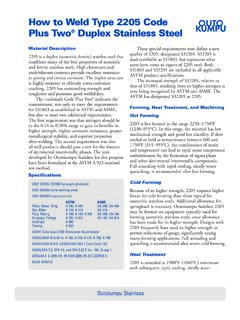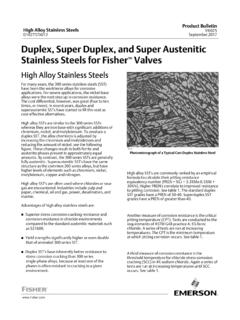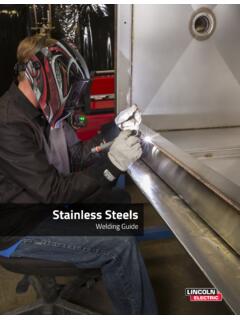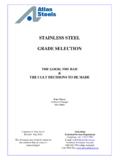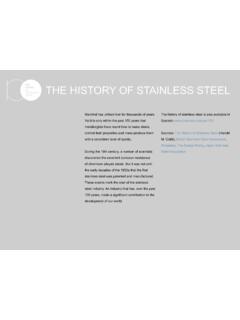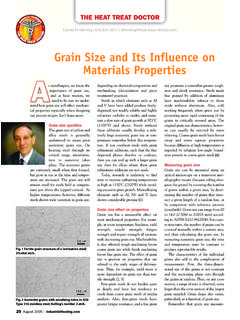Transcription of Caustic Stress Corrosion Cracking | No. 13
1 Caustic Stress Corrosion Cracking | No. 13 Corrosion in Caustic Solutions Corrosion by Caustic (sodium or potassium hydroxide) at all concentrations is easily handled at room temperature with a variety of metals and alloys, including carbon steels. It becomes increasingly more corrosive with increasing temperature and concentration. The useful safe limit of carbon steel is approximately 150oF/65oC, with regard to Corrosion . With regard to the safe temperature for carbon steel , the reader should look at the curve in Figure 1.
2 stainless steels are more resistant to general Corrosion compared with carbon steel ; however, they can suffer Caustic Stress Corrosion Cracking (CSCC) at approximately 250oF/121oC. As a general rule, the resistance to Caustic solutions increases with increasing nickel content. Susceptibility to Caustic SCC depends on several variables including alloy content, Caustic concentration, temperature, and Stress level. As with other Cracking mechanisms, there is a threshold Stress level where Cracking will not occur; unfortunately, the threshold level for the high nickel alloys in high-temperature Caustic has not been determined precisely.
3 Much data has been obtained on alloy 600 in Caustic environments because of its extensive use as steam generator tubing in pressure water reactors (PWR). Alloy 200 (pure nickel) is considered to be immune to all but the most severe Caustic environments, including molten Caustic . Corrosion Resistance of Alloys to Caustic Solutions Carbon and Low Alloy Steels. Sodium and potassium hydroxides (both hereafter referred to as Caustic ) are commonly handled and stored at ambient temperatures in all concentrations with carbon steel equipment. At temperatures above ambient, Corrosion rates of carbon steel become greater and is accompanied by a risk of CSCC.
4 Low concentrations of Caustic can be safely handled by carbon steel up to 180oF/82oC, where CSCC starts to become a risk factor, while the safe upper limit for a 50% solution is approximately 120oF/48oC. The Caustic Soda Service Chart (Figure 1) is a widely used guide for determining safe operating temperatures with respect CSCC of carbon steels at various concentrations of Caustic . The photomicrograph in Figure 2 shows Caustic Cracking of a carbon steel pipe. Ferritic stainless Steels. The high purity ferritic stainless steels, such as E-Brite 26-1 (UNS S44627), exhibit excellent resistance to aggressive Caustic solutions with performance far superior to the austenitic stainless steels and, reportedly, at least as good as nickel.
5 This superior resistance in some Caustic solutions has been attributed to the presence of hypochlorates or chlorate contaminants, which are detrimental to nickel alloys. One source reports that 26-1 is useful up to 300oF/148oC to 350oF/177oC. Another reports good resistance at 350oF/177oC - 400oF/204oC and 45% NaOH Based on their good resistance to Caustic , particularly those containing oxidizing contaminants, they see extensive use as Caustic evaporator tubes. However, the Achilles Heel of the ferritic stainless steels is the inherent poor toughness of welded joints and low strength at elevated temperatures.
6 They are, therefore, not normally used for pressure vessel applications. Austenitic stainless Steels. Researchers using solutions of commercially pure Caustic developed a diagram that attempts to delineate the parameters of concentration and temperature governing Caustic embrittlement, , SCC of the 300 series austenitic stainless steels. Figure 3 shows the chart developed. The 1 mpy isocorrosion line is constant at approximately 100 C from 20-60% Caustic and the delineation for SCC is slightly higher in the 40-50% range. In actuality, it has been observed that there is a real possibility that the type 300 series grades may lose their passivity and undergo rapid general The distribution of MTI documents to non-member companies is done as a service to industry.
7 MTI assumes no responsibility for the contents or for results associated with implementing any recommendations. Copyright 2012 Materials Technology Institute, Inc. All Rights Reserved. Corrosion in hot 40-50% Caustic . Probable safe limits are well below those indicated in the curve, , 70 C for 50% Caustic and 80 C for 40% common service maximum temperature limit for 304/316 type stainless steel is 100 C. Caustic Cracking can occur at higher temperatures. SCC of the 300 series stainless steels is classically transgranular. duplex stainless Steels. The duplex stainless steels were developed to exhibit comparable general Corrosion resistance as 316SS, but with reduced susceptibility to chloride Stress Corrosion Cracking .
8 The higher alloyed duplex stainless steel alloys, ones with significant molybdenum and nitrogen additions, can be superior to 316 SS in Caustic environments. Grades 2205 and 2906 are reported to have useful Caustic Cracking resistance. High Nickel Austenitic stainless Steels. The high nickel family of stainless steels are those containing approximately 25-35 wt. % nickel, and include such non-patented and proprietary alloys as 904L, Sanicro 28, alloy 20Cb-3, alloy 800, Al6-XN etc. With these alloys, resistance to aggressive (high temperature) Caustic solutions increases significantly compared with the 300-series stainless steels.
9 Nickel Alloys. Commercially pure nickel, alloy 200 (N02200) and alloy 201 (N02201) are the best materials for resisting Corrosion and Stress Corrosion Cracking in Caustic environments. Alloy 400 (N04400) and alloy 600 (N06600) also have excellent Stress Corrosion resistance. These alloys can however suffer from Caustic Stress Corrosion Cracking at Caustic concentrations above 70% at temperatures above 290 C (550 F). The Ni-Cr-Mo alloys such as C-276 (N10276) also have useful Caustic Cracking resistance, however are susceptible to Caustic Cracking at high concentrations and temperatures.
10 Figure 4 shows the SCC range of nickel and other nickel alloys. Figure 1. Caustic service chart for carbon steel . Recommended Reference: MTI Publication MS-6, Material Selector for Hazardous Chemicals -Ammonia and Caustic Originally published: November 2008 Figure 2. Caustic Stress Corrosion crack in carbon steel . (MSR Photo) The distribution of MTI documents to non-member companies is done as a service to industry. MTI assumes no responsibility for the contents or for results associated with implementing any recommendations. Copyright 2012 Materials Technology Institute, Inc. All Rights Reserved.


